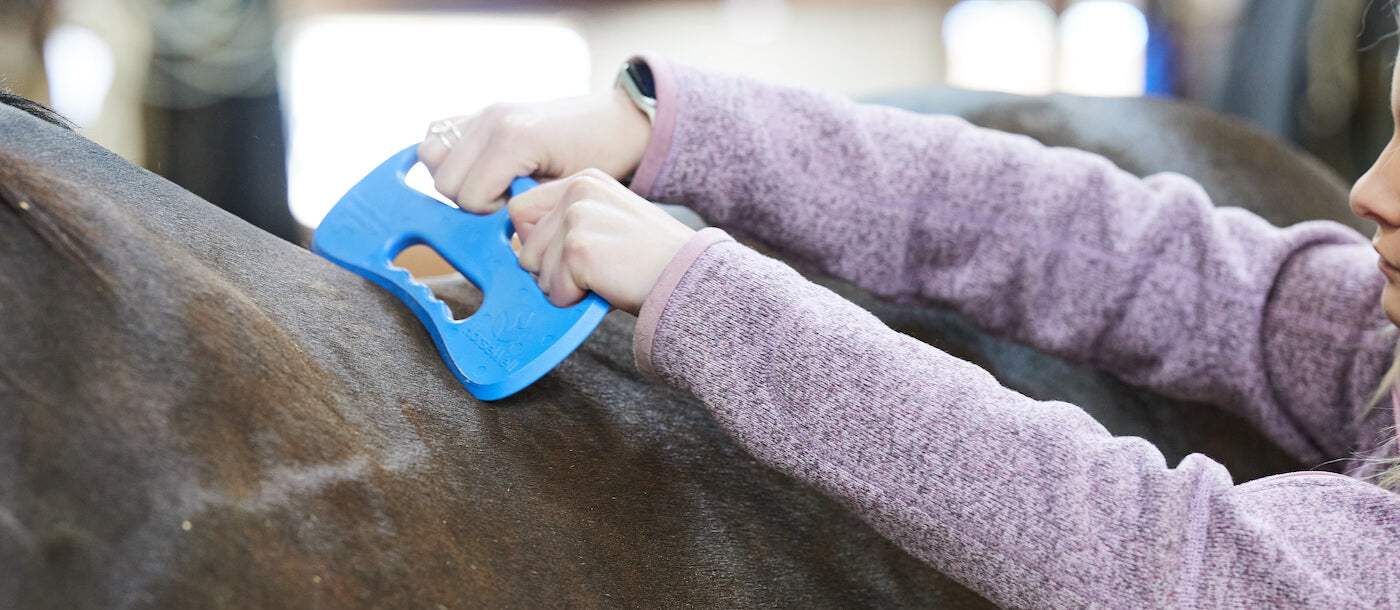
Massage Therapy for Horses with Horsewell
Horse massage therapy using Myofascial techniques is a form of bodywork that focuses on releasing tension and restrictions in the fascia, a layer of connective tissue that surrounds and supports the muscles, bones, and organs of the horse's body. This technique can help improve flexibility, range of motion, and the overall well-being of your horse.
Myofascial release involves applying gentle pressure and stretching to specific areas of the horse's body, with the goal of releasing tension and restoring balance to the fascial system. Horsewell has designed a product-line of Myofascial release tools that include massage balls, rollers and stretchers. When using Myofascial techniques, it is important to work with a qualified and experienced therapist or practitioner who is trained in this technique. They can help assess your horse's needs and develop a treatment plan that is tailored to their individual needs.
Benefits to Massage Therapy
Massage therapy can be beneficial for horses in a number of ways!
- Promotes relaxation : Just like humans, horses can hold tension in their muscles, which can cause discomfort and stiffness.
- Reduces pain : If your horse is experiencing pain due to an injury or chronic condition, massage therapy can be an effective way to reduce discomfort and help your horse feel more comfortable.
- Improves circulation : Massage can help to increase blood flow and lymphatic flow in your horse's body, which can help to flush out toxins and bring fresh oxygen and nutrients to the muscles.
- Enhances performance : Massage therapy can help to improve range of motion, flexibility, and overall athletic performance in horses
- Builds trust and bonding : Massage therapy can be a great way to bond with your horse and build trust. By spending time working on your horse's body, you may be able to deepen your connection and understanding of each other.
How to Massage a Horse
Massaging a horse using a massage tool can be a great way to help your horse relax, improve circulation, and relieve sore muscles. Here are some steps to follow:
- Choose the right massage tool : There are different types of massage tools available, including handheld massagers, massage gloves, and massage pads. Choose one that suits your horse's needs and your own preferences.
- Start with a warm-up : Before you start massaging, warm up your horse by walking him for a few minutes. This will help increase circulation and prepare the muscles for the massage.
- Begin the massage : Start by applying the massage tool to your horse's neck or shoulders. Use slow, circular movements and apply gentle pressure. As your horse begins to relax, you can move on to other areas of the body.
- Pay attention to your horse's reactions : Observe your horse's reactions and adjust your pressure and speed accordingly. Some horses may prefer more pressure, while others may need a lighter touch.
- Work on problem areas : If your horse has specific problem areas, spend extra time massaging those areas. This can help relieve soreness and tension.
- End with a cool-down : After you finish the massage, walk your horse for a few minutes to cool down his muscles.
Remember to always prioritize the horse's comfort and safety when massaging them. If your horse shows signs of discomfort or pain, stop the massage immediately and consult with a veterinarian.
Key Pressure Points to Massage
When massaging your horse, there are several key pressure points that you can focus on to help promote relaxation and relieve tension.
- Withers : The withers are located where the neck meets the back. Massaging this area can help release tension in the neck and shoulder muscles.
- Shoulders : The shoulder area is a common area of tension in horses. Use circular motions and gentle pressure to help release tension.
- Back : The back is another area where horses tend to carry tension. Use long, flowing strokes along the spine to help relax the muscles.
- Hindquarters : The hindquarters are an important area to massage, as they can affect your horse's movement and performance. Focus on the gluteal muscles and the area around the tailbone.
- Legs : The legs are also important to massage, as they can become sore or stiff from exercise. Pay particular attention to the muscles around the knees and hocks.
When massaging these areas, remember to start with gentle pressure and gradually increase as your horse becomes more comfortable. Adjust your pressure and technique as needed. It is also important to avoid any areas that are sensitive or painful to your horse.
Megan Wells - Creator of the HorseWell Massager
Created by a registered nurse who is an avid horse lover, trainer, rancher and mother of two.
"My husband, kids and I live on our family ranch in Wyoming where we raise black angus cattle. We also enjoy training horses from breaking them as colts to finishing their training in roping and barrel racing events.
While working at the hospital, I witnessed relief and results in patients that received myofascial release. From there I just knew the horse industry needed to know the benefits of myofascial release.
The HorseWell Massager was made specifically for the equine anatomy. I found it to be incredibly helpful for our performance horses and ranch horses."






